Laboratory Test of a Vehicle Active Noise-Control System Based on an Adaptive Step Size Algorithm
Abstract
1. Introduction
2. Methods
2.1. Active Noise Control Structure
2.2. FxLMS Algorithm
2.3. FxLMS Algorithm with Adaptive Step Size
2.4. Adaptive Step Size Algorithm, Based on Particle Swarm Optimization
3. Simulation Analysis
4. Laboratory Experiment
4.1. Vehicle Internal Noise Acquisition
4.2. The ANC Experiments
5. Discussion and Conclusions
- (1)
- The AASFxLMS algorithm proposed in this paper adjusts the step size according to the size of the reference signal, which can effectively cope with the impact noise signal and further improve its performance via particle swarm optimization.
- (2)
- The MATLAB simulation results show that, compared with the FxLMS algorithm, MNFxLMS algorithm, NASFSxLMS algorithm, and NASFSxLMSPSO algorithm, the proposed AASFxLMS algorithm and AASFxLMSPSO algorithm have better noise reduction performance. In the case of faster convergence, the steady-state error is lower.
- (3)
- As shown by the collection of the interior noise signal and the hardware-in-the-loop test in the noise suppression room, the noise reduction amplitude can reach 12 dB, which verifies the reliability and effectiveness of the proposed algorithm in terms of interior noise active control.
- (4)
- In this paper, the noise reduction effect of the proposed algorithm is verified only in the laboratory. The most necessary future development is a test conducted in a car running over speed bumps.
- (5)
- In addition to the classical particle swarm optimization algorithm to optimize parameters a and c, the process can also be realized by using a neural network algorithm, genetic algorithm, ant colony algorithm, or bee colony algorithm.
- (6)
- As another future development direction, the potential applications of the in-vehicle active noise control system proposed in this paper can also include aircraft, ships, offices, and other indoor application scenarios.
Author Contributions
Funding
Institutional Review Board Statement
Informed Consent Statement
Data Availability Statement
Acknowledgments
Conflicts of Interest
References
- Liao, L.; Zuo, Y.; Meng, H.; Liao, X. Research on the technology of noise reduction in hybrid electric vehicle with composite materials. Adv. Mech. Eng. 2018, 10, 168781401876691. [Google Scholar] [CrossRef]
- Kim, W.-T.; Chung, K.-H. Study on the Design of Butyl Rubber Compound and Noise Reduction System for Sound Insulation. Elastomers Compos. 2014, 49, 95–102. [Google Scholar] [CrossRef]
- Hu, Q.S.; Ni, F.; Zuo, S.G.; Lin, J.P.; Fang, D.G.; Guo, F.X. Investigation on Technology of Automobile Vibration and Noise Reduction Based on Body-In-White Structure. Key Eng. Mater. 2011, 474–476, 676–680. [Google Scholar] [CrossRef]
- Fuchen, D. Research and Application of Active Control System for Vehicle Noise. Master’s Thesis, Harbin Institute of Technology, Harbin, China, 2019. [Google Scholar]
- Chuliang, L. Research on Vehicle Active Noise Control Method. Master’s Thesis, Xiangtan University, Xiangtan, China, 2018. [Google Scholar]
- Kinoshita, A.; Tabata, T.; Doi, K.; Nakaji, Y. Active booming noise control system for automobiles. Int. J. Veh. Des. 1994, 15, 108–118. [Google Scholar] [CrossRef]
- Bohn, C.; Cortabarria, A.; Härtel, V.; Kowalczyk, K. Active control of engine-induced vibrations in automotive vehicles using disturbance observer gain scheduling. Control Eng. Pract. 2003, 12, 1029–1039. [Google Scholar] [CrossRef]
- Takahashi, A.; Inoue, T.; Sakamoto, K.; Kobayashi, Y. Integrated active noise control system for low-frequency noise in automobiles. In Proceedings of the INTER-NOISE and NOISE-CON Congress and Conference Proceedings, Osaka, Japan, 4–7 September 2011. [Google Scholar]
- Jiang, J.G.; Zeng, Y. Adaptive Active Control System of Vehicle Noise Design and Test. Adv. Mater. Res. 2014, 1028, 251–256. [Google Scholar] [CrossRef]
- Sun, G.; Duan, J.; Li, M.; Lim, T.C. Numerical modeling and active noise control of impact road noise inside a vehicle compartment. Noise Control Eng. J. 2015, 63, 72–85. [Google Scholar] [CrossRef]
- Feng, T.; Sun, G.; Li, M.; Lim, T.C. Channel self-adjusting filtered-x LMS algorithm for active control of vehicle road noise. Int. J. Veh. Noise Vib. 2017, 13, 267. [Google Scholar] [CrossRef]
- Zhu, L.; Yang, T.; Li, X.; Pang, L. Active Control of Broadband Noise Inside a Car Using a Causal Optimal Controller. Appl. Sci. 2019, 9, 1531. [Google Scholar] [CrossRef]
- Li, H.; Zhang, S. Research On Active Control System Of Vehicle Noise Caused By Pavement Excitation. IFAC-PapersOnLine 2018, 51, 467–472. [Google Scholar] [CrossRef]
- Leahy, R.; Zhou, Z.; Hsu, Y.C. Adaptive fifiltering of stable processes for active attenuation of impulsive noise. In Proceedings of the IEEE International Conference on Acoustic, Speech and Signal Processing, Detroit, MI, USA, 9–12 May 1995; Volume 5, pp. 2983–2986. [Google Scholar]
- Sun, X.; Kuo, S.M.; Meng, G. Adaptive algorithm for active control of impulsive noise. J. Sound Vib. 2005, 291, 516–522. [Google Scholar] [CrossRef]
- Akhtar, M.T.; Mitsuhashi, W. Improving robustness of filtered-x least mean p-power algorithm for active attenuation of standard symmetric-α-stable impulsive noise. Appl. Acoust. 2011, 72, 688–694. [Google Scholar] [CrossRef]
- Li, P.; Yu, X. Active noise cancellation algorithms for impulsive noise. Mech. Syst. Signal Process 2013, 36, 630–635. [Google Scholar] [CrossRef] [PubMed]
- Zhou, Y.; Zhang, Q.; Yin, Y. Active control of impulsive noise with symmetric α-stable distribution based on an improved step-size normalized adaptive algorithm. Mech. Syst. Signal Process 2014, 56–57, 320–339. [Google Scholar] [CrossRef]
- Song, P.; Zhao, H. Filtered-x generalized mixed norm (FXGMN) algorithm for active noise control. Mech. Syst. Signal Process 2018, 107, 93–104. [Google Scholar] [CrossRef]
- Meng, H.; Chen, S. Particle swarm optimization based novel adaptive step-size FxLMS algorithm with reference signal smoothing processor for feedforward active noise control systems. Appl. Acoust. 2021, 174, 107796. [Google Scholar] [CrossRef]
- Pengxing, F.; Lijun, Z.; Dejian, M.; Xiongfei, P. An active impulsive noise control algorithm with self-p-normalized method. Appl. Acoust. 2021, 186, 108428. [Google Scholar] [CrossRef]
- Gu, F.; Chen, S.; Zhou, Z.; Jiang, Y. An enhanced normalized step-size algorithm based on adjustable nonlinear transformation function for active control of impulsive noise. Appl. Acoust. 2021, 176, 107853. [Google Scholar] [CrossRef]
- Zeb, A.; Mirza, A.; Khan, Q.U.; Sheikh, S.A. Improving performance of FxRLS algorithm for active noise control of impulsive noise. Appl. Acoust. 2017, 116, 364–374. [Google Scholar] [CrossRef]
- Zhang, J.; Elliott, S.J.; Cheer, J. Robust performance of virtual sensing methods for active noise control. Mech. Syst. Signal Process 2021, 152, 107453. [Google Scholar] [CrossRef]
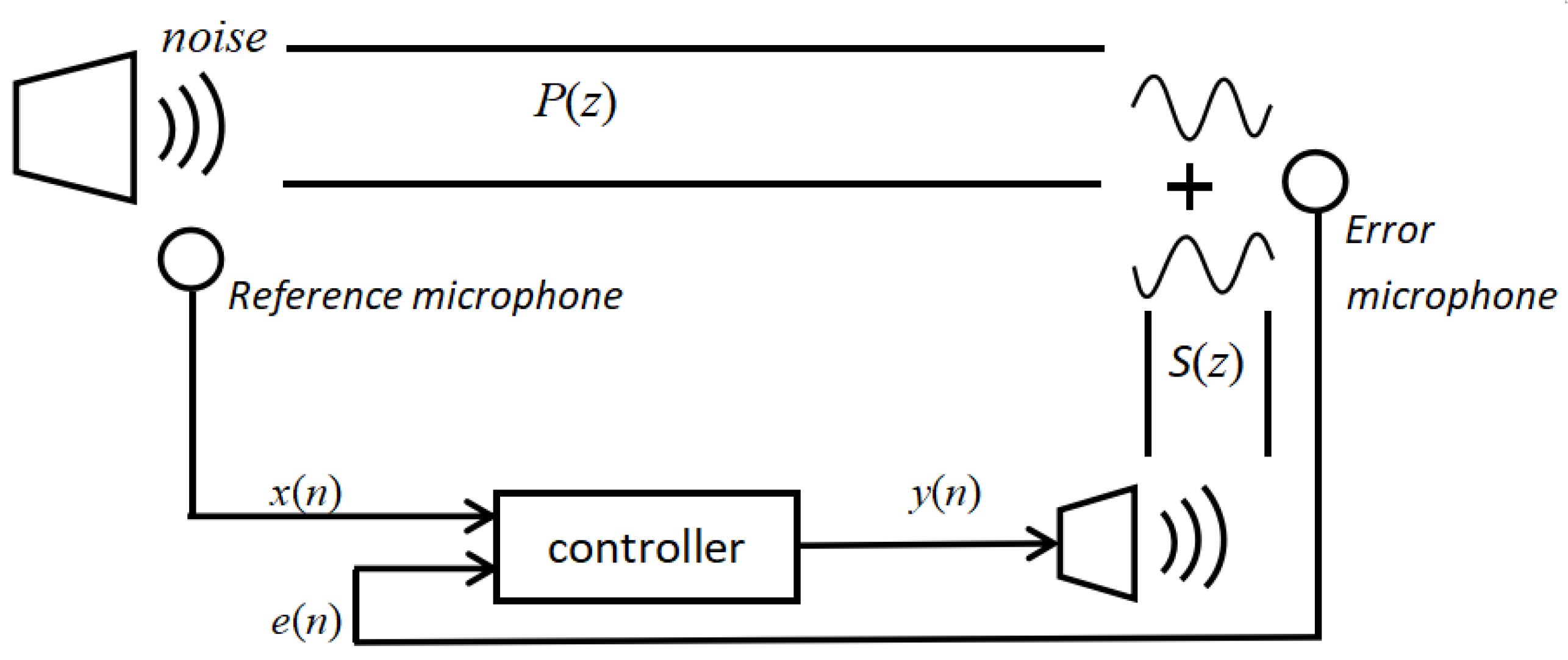
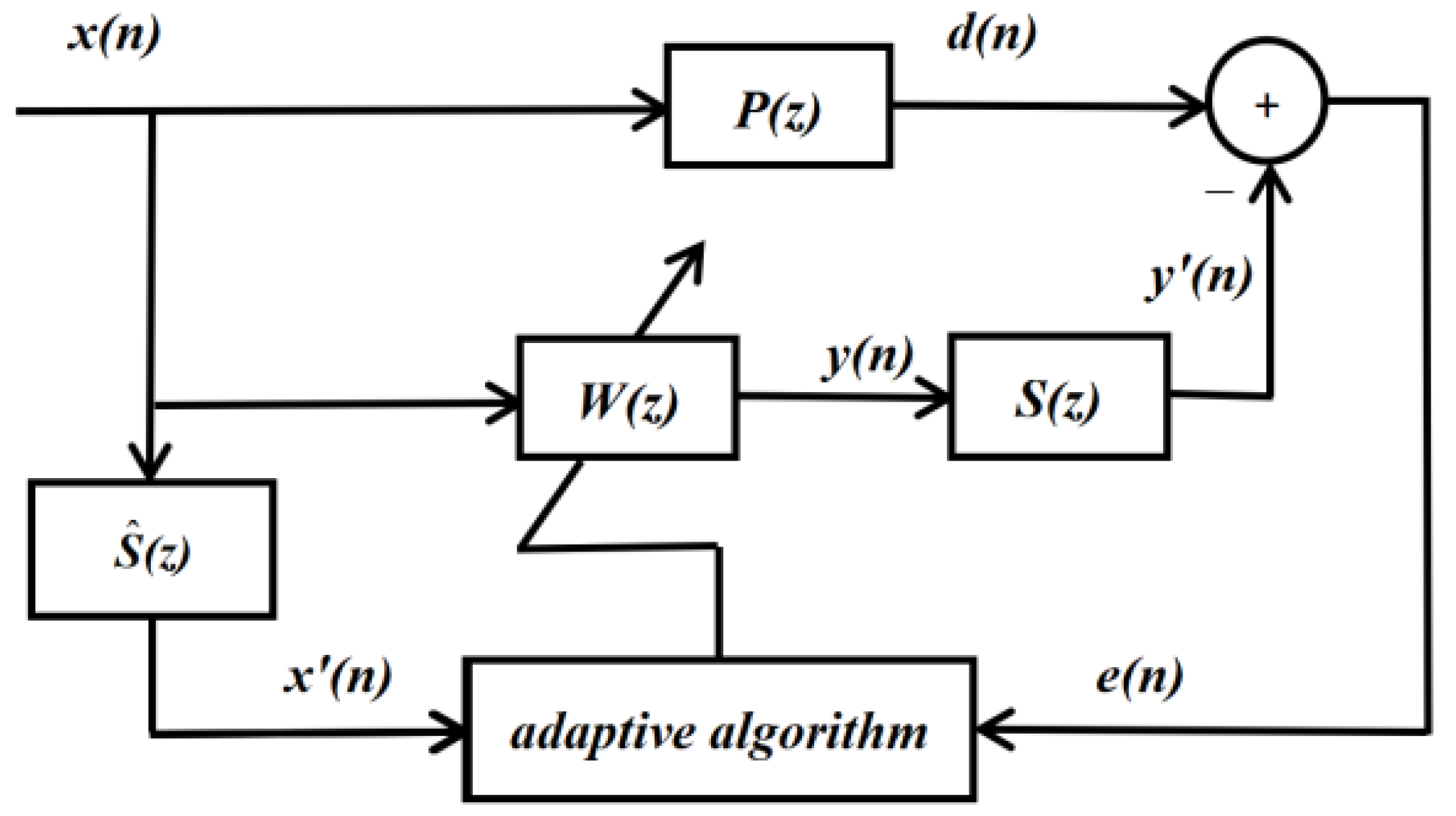
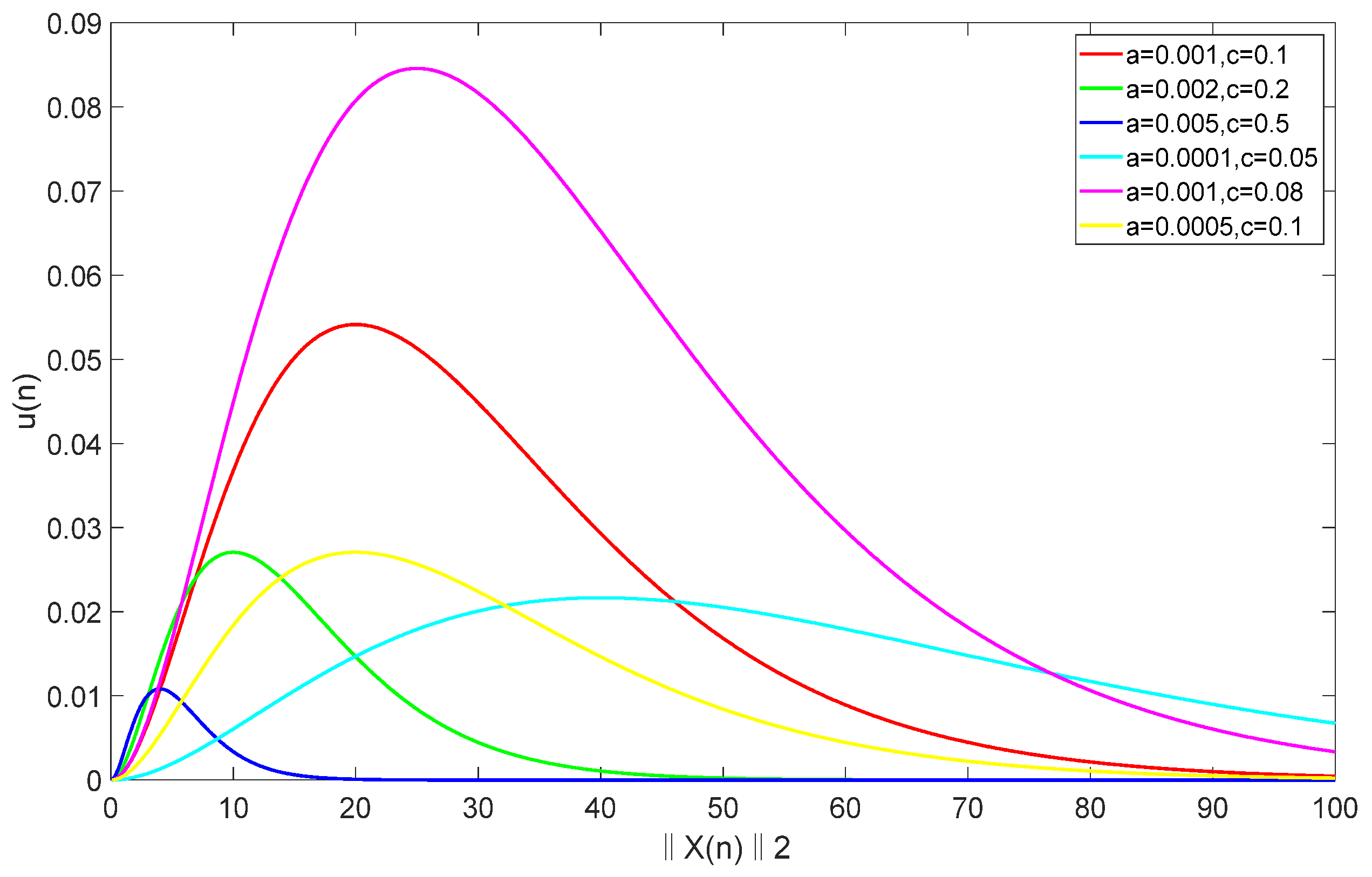




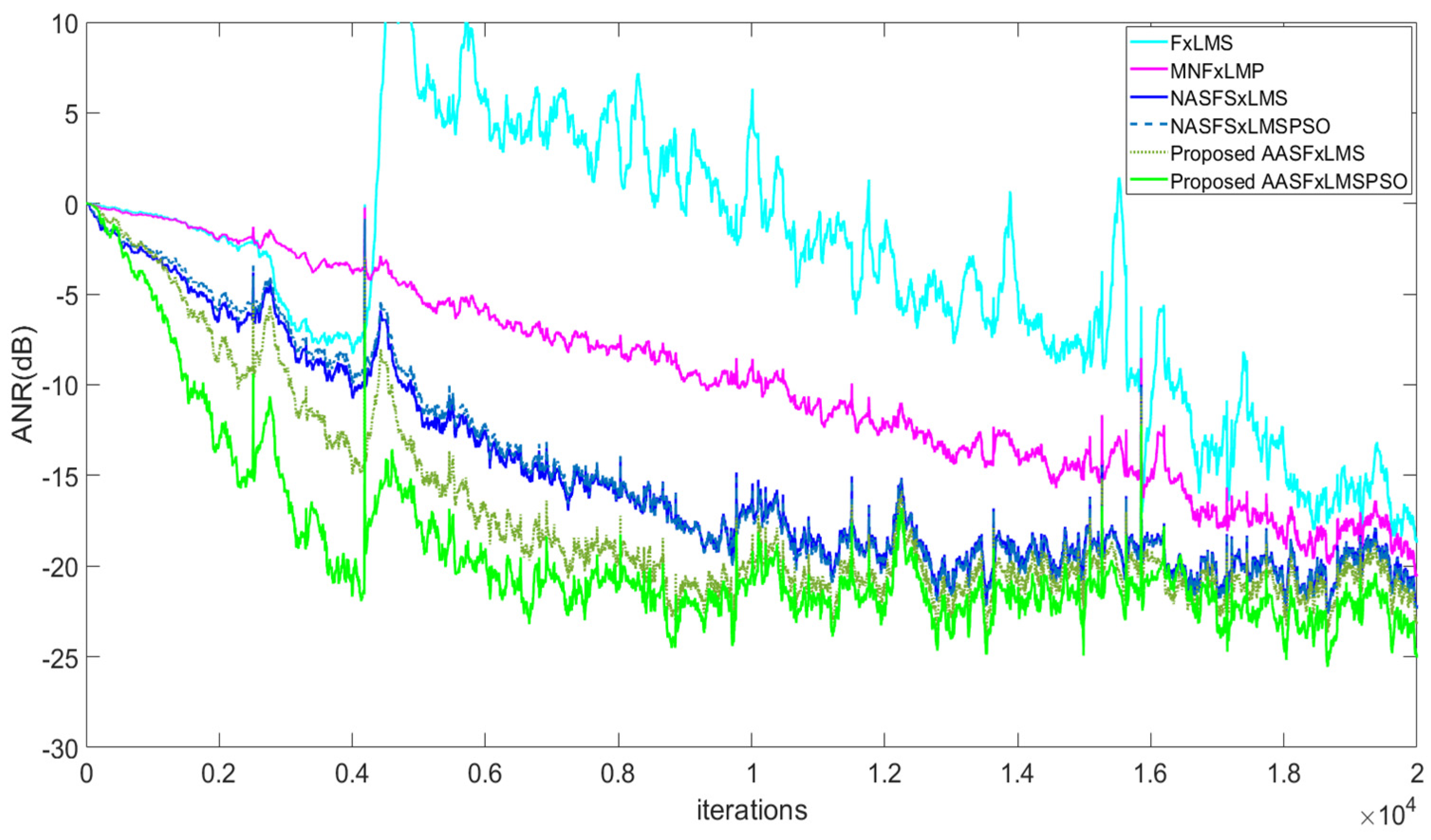
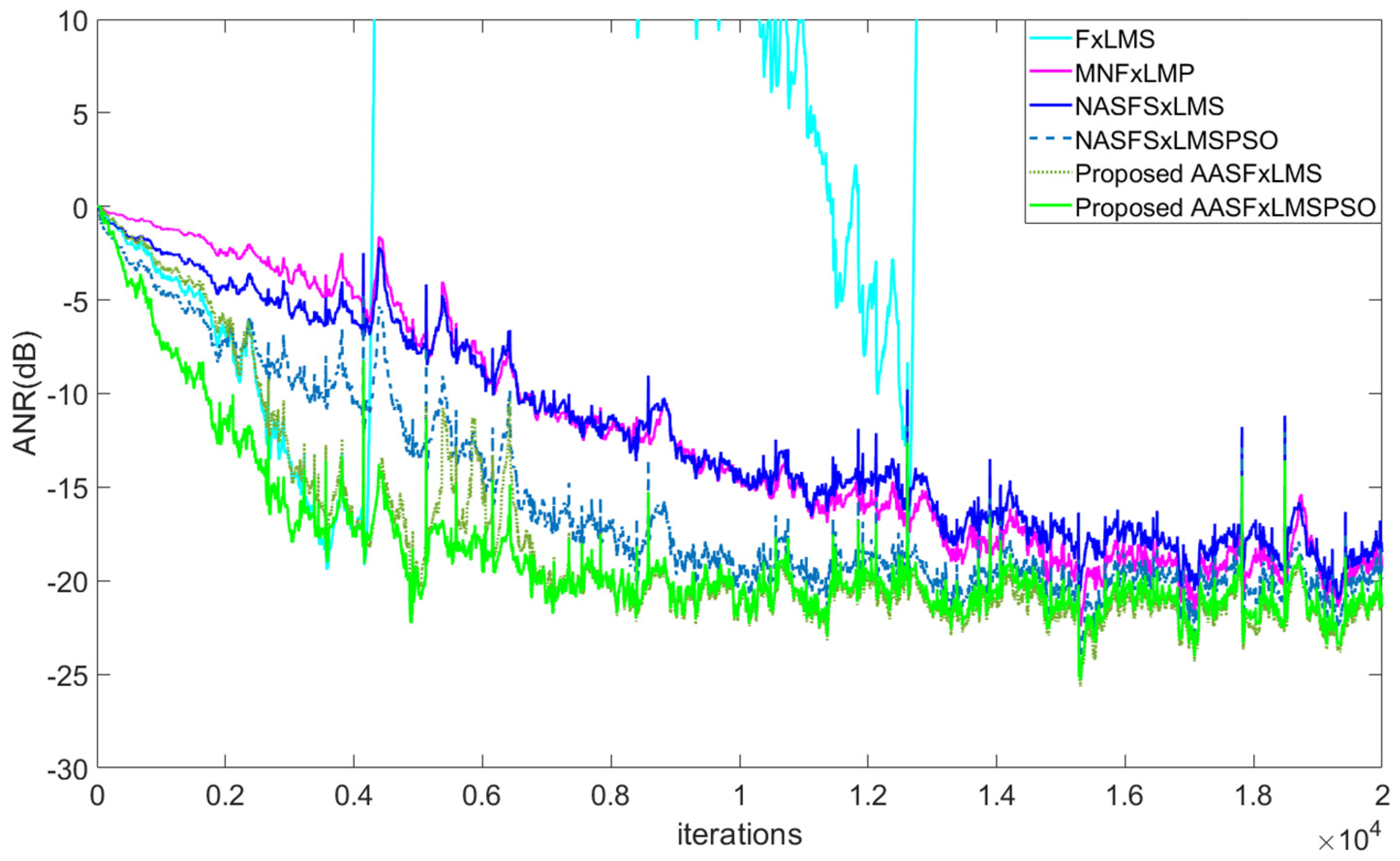

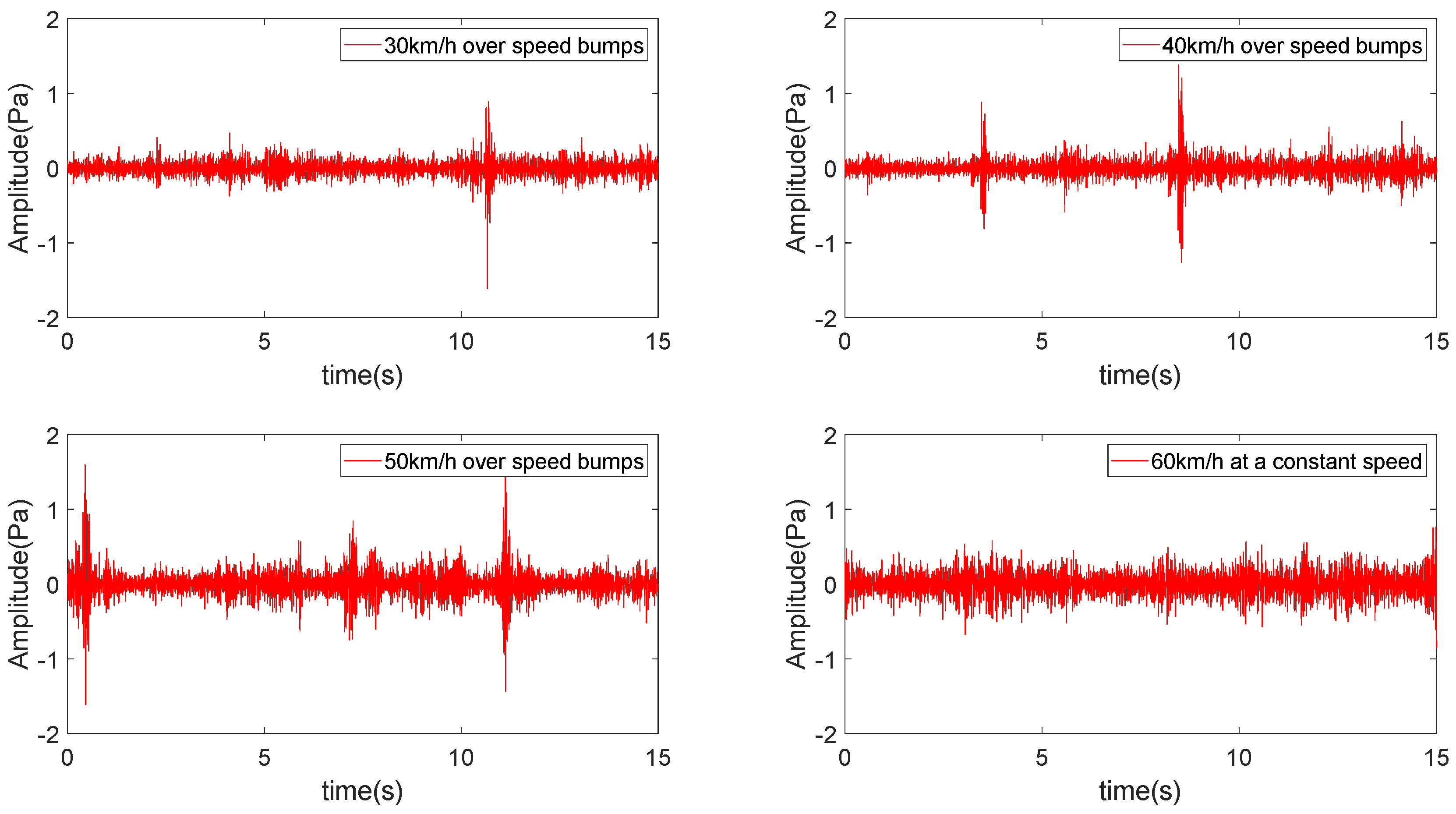
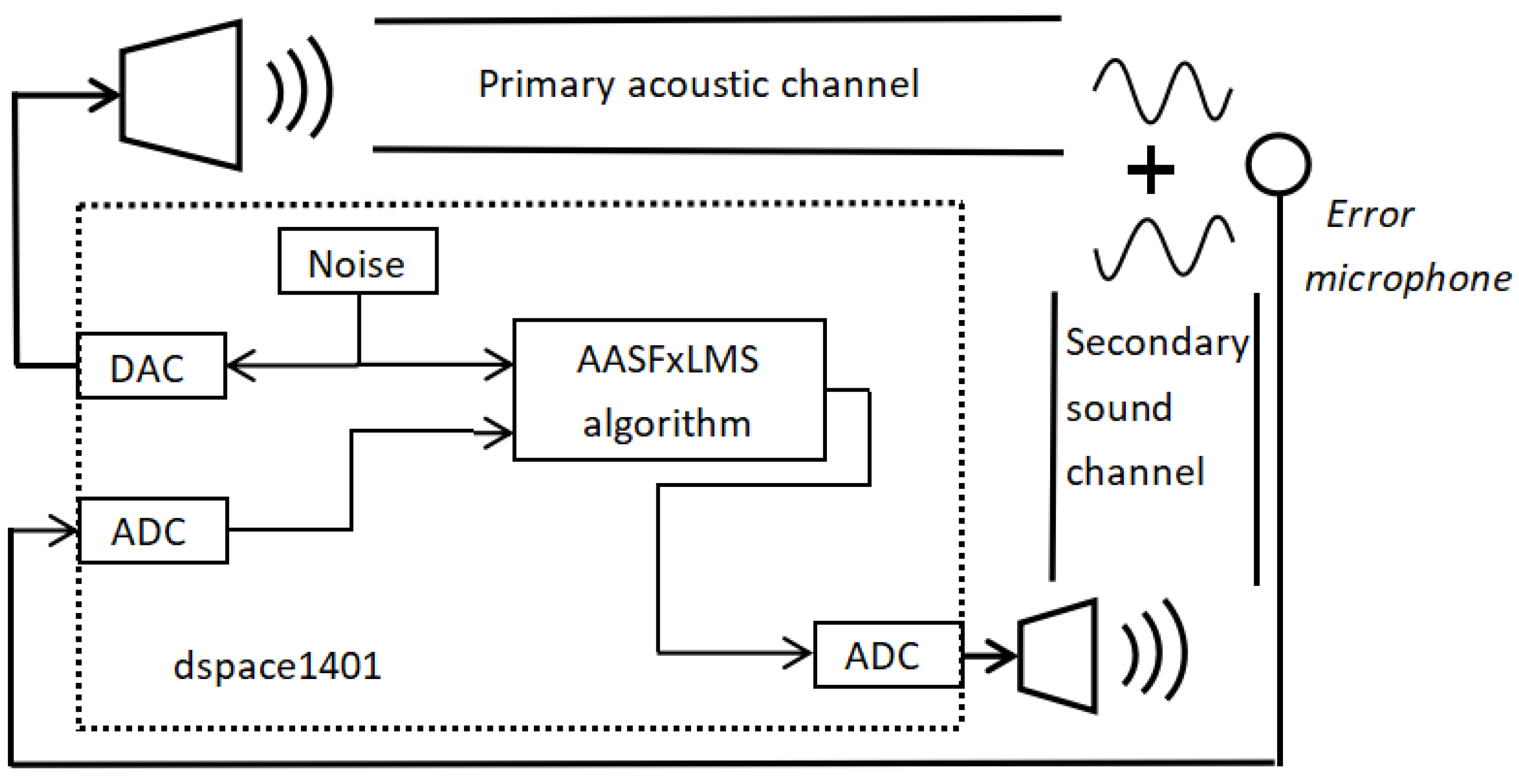
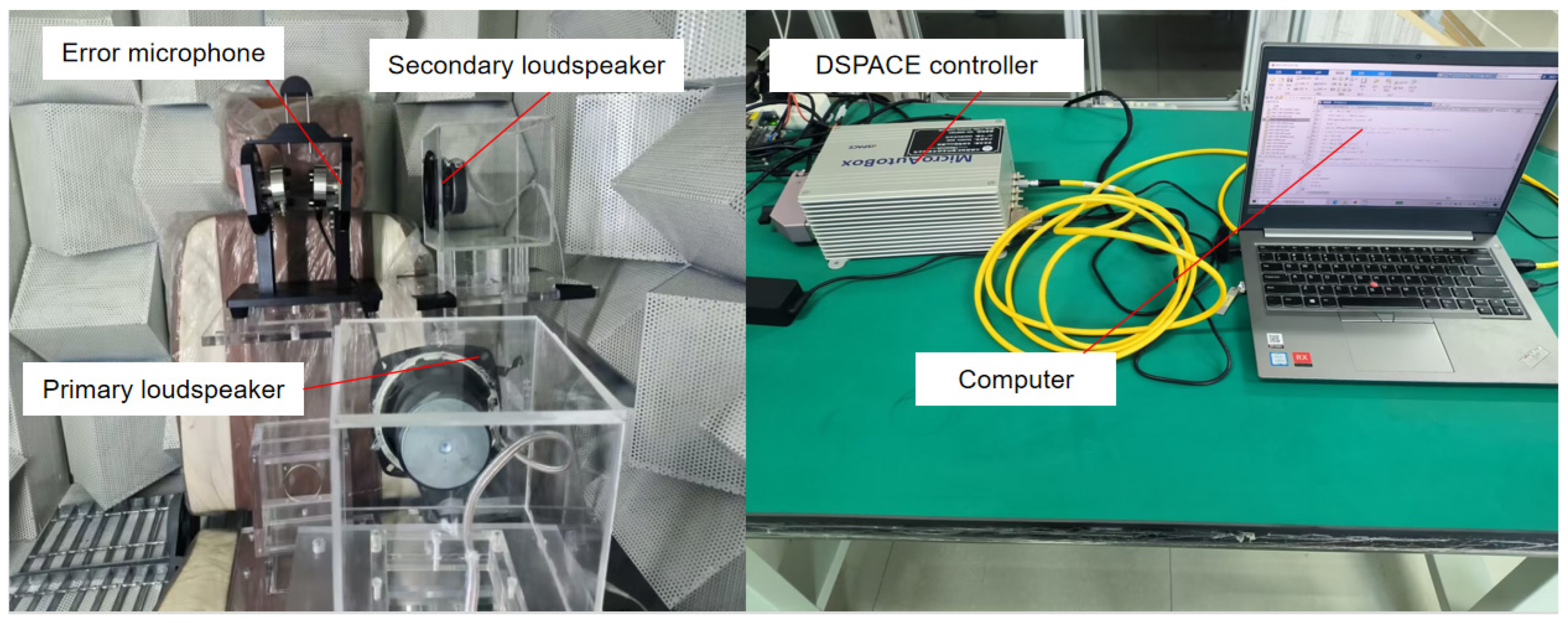
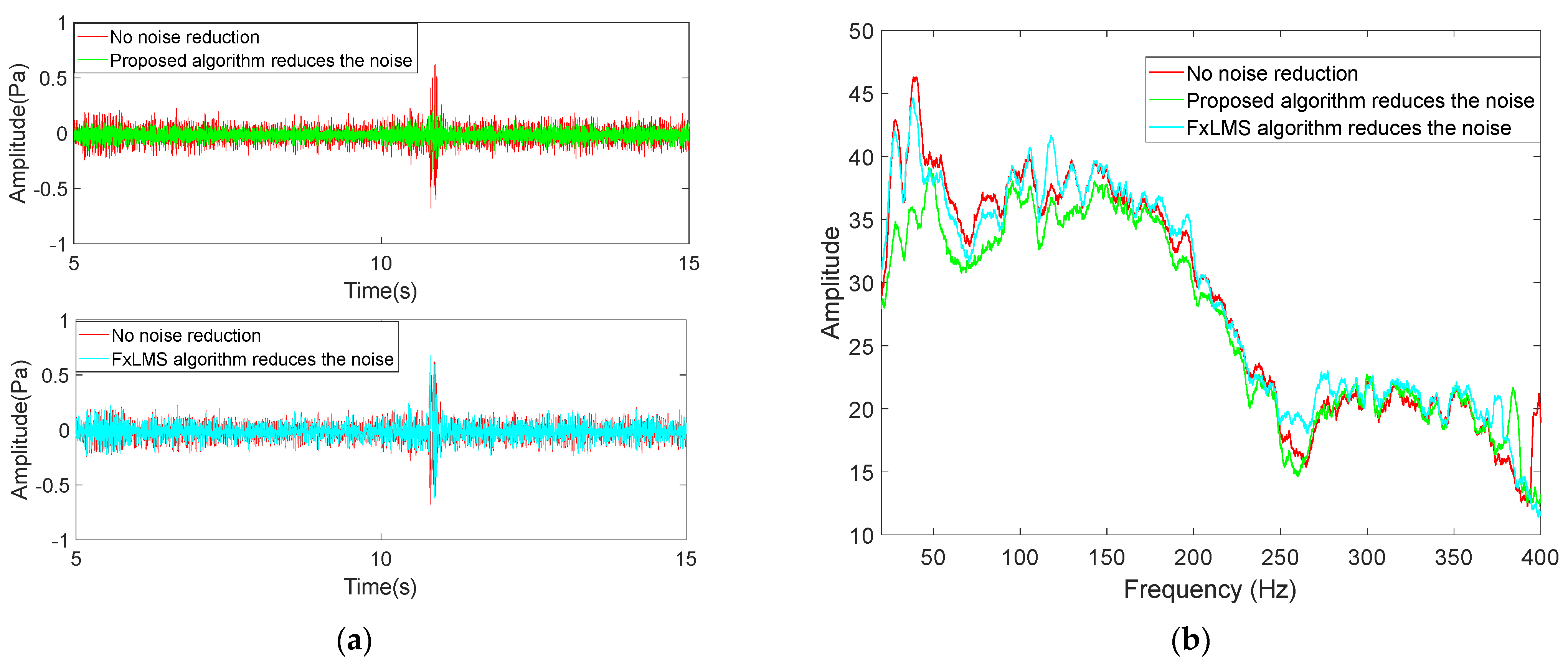


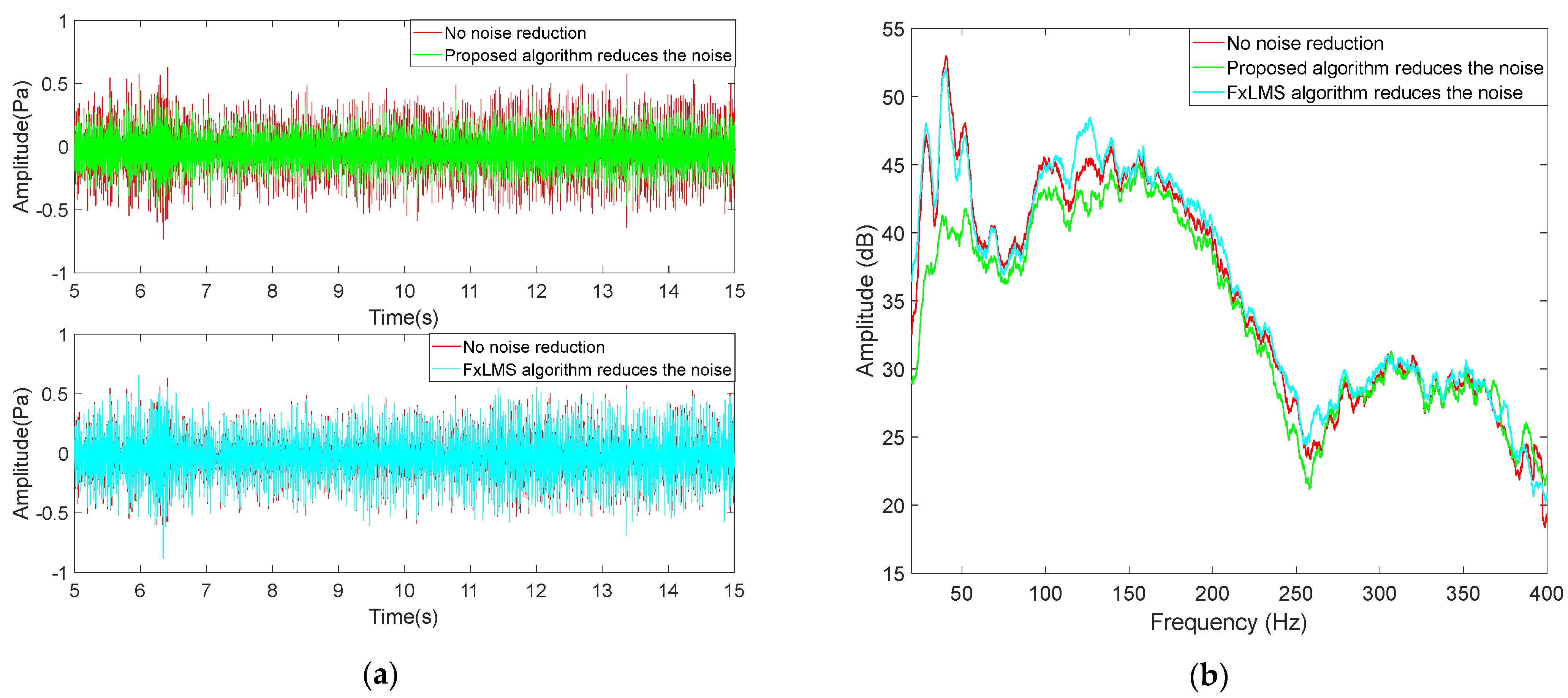
| FxLMS | u = 0.00005 |
| MNFxLMS | p = 1.59, µ = 2.5 × 10−3 |
| NASFSxLMS | ρ = 0.25, γ = 1.6 |
| NASFSxLMSPSO | ρ = 0.2514, γ = 1.3826, ω = 0.6, C1 = 2, C2 = 2, p =50, δ = 0.000001, m = 10, G = 100 |
| AASFxLMS | a = 0.001, c = 0.05 |
| AASFxLMSPSO | alimt = [0.0005, 0.002], alimt = [0.04, 0.08], K = 1000, ω = 0.6, m1 = 2, m2 = 2, p =5, r = 10 |
| FxLMS | u = 0.00005 |
| MNFxLMS | p = 1.59, µ = 2.0 × 10−3 |
| NASFSxLMS | ρ = 0.3, γ = 1.2 |
| NASFSxLMSPSO | ρ = 0.4524, γ = 1.1458, ω = 0.6, C1 = 2, C2 = 2, p =50, m = 10, G = 100 |
| AASFxLMS | a = 0.0005, c = 0.05 |
| AASFxLMSPSO | alimt = [0.0001, 0.001], climt = [0.02, 0.06], K = 1000, ω = 0.6, m1 = 2, m2 = 2, p =5, r = 10 |
| FxLMS | u = 0.00005 |
| MNFxLMS | p = 1.59, µ = 2.0 × 10−3 |
| NASFSxLMS | ρ = 0.3, γ = 1.2 |
| NASFSxLMSPSO | ρ = 0.3843, γ = 1.2868, ω = 0.6, C1 = 2, C2 = 2, p =50, m = 10, G = 100 |
| AASFxLMS | a = 0.0005, c = 0.05 |
| AASFxLMSPSO | alimt = [0.0001, 0.001], climt = [0.02, 0.04], K = 1000, ω = 0.6, m1 = 2, m2 = 2, p =5, r = 10 |
Disclaimer/Publisher’s Note: The statements, opinions and data contained in all publications are solely those of the individual author(s) and contributor(s) and not of MDPI and/or the editor(s). MDPI and/or the editor(s) disclaim responsibility for any injury to people or property resulting from any ideas, methods, instructions or products referred to in the content. |
© 2022 by the authors. Licensee MDPI, Basel, Switzerland. This article is an open access article distributed under the terms and conditions of the Creative Commons Attribution (CC BY) license (https://creativecommons.org/licenses/by/4.0/).
Share and Cite
Jiang, T.; Liu, J.; Peng, C.; Wang, S. Laboratory Test of a Vehicle Active Noise-Control System Based on an Adaptive Step Size Algorithm. Appl. Sci. 2023, 13, 225. https://doi.org/10.3390/app13010225
Jiang T, Liu J, Peng C, Wang S. Laboratory Test of a Vehicle Active Noise-Control System Based on an Adaptive Step Size Algorithm. Applied Sciences. 2023; 13(1):225. https://doi.org/10.3390/app13010225
Chicago/Turabian StyleJiang, Tao, Jiang Liu, Cheng Peng, and Shuliang Wang. 2023. "Laboratory Test of a Vehicle Active Noise-Control System Based on an Adaptive Step Size Algorithm" Applied Sciences 13, no. 1: 225. https://doi.org/10.3390/app13010225
APA StyleJiang, T., Liu, J., Peng, C., & Wang, S. (2023). Laboratory Test of a Vehicle Active Noise-Control System Based on an Adaptive Step Size Algorithm. Applied Sciences, 13(1), 225. https://doi.org/10.3390/app13010225





